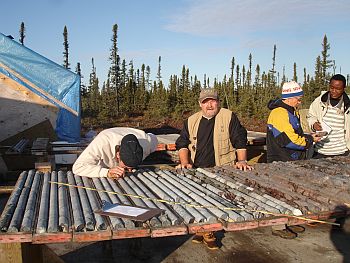Spider Resources touts chromite discovery

Spider Resources Inc.'s exploration prowess has led to some ground-breaking discoveries for the company and its joint venture partners in the James Bay Lowlands.
Company president Neil Novak made discoveries that precipitated two staking rushes in the swampy region of Northern Ontario. On March 8, 2010, he will be one of five people receiving the Bill Dennis award from the Prospectors & Developers Association of Canada in recognition of his prospecting success.
Novak, who has been with Spider Resources since its inception in 1992, transitioned the company from a private enterprise to a public corporation. Two other board of director members have also accompanied Novak from Spider's humble beginnings as a diamond explorer to the savvy junior miner that has been busy charting new territory in the McFaulds Lake mining camp now known as the Ring of Fire.
Beginning in 1994, Spider Resources partnered with KWG Resources Inc. to explore for kimberlites, host sites for diamonds. Exploration eventually led to the discovery of volcanic massive sulphide (VMS) anomalies in 2002, which set the stage for new base metal discoveries and the region's first staking rush. Copper/zinc mineralization spurred the juniors westward to the eventual discovery of a chromite deposit that is being recognized as world-class, capturing the attention of international mining companies.
Novak, who wore several hats during the initial exploration phase of the Ring of Fire, played a strategic role in discovering Noront Resources Ltd.'s Eagle One property, a high-grade nickel, copper, and platinum group metals deposit.
"What is unique about the Eagle discovery is that it is in the base of a peridotite, an intrusion. The bottom is where the nickel sulphides accumulate. Sitting higher up on the intrusion is where Noront found the chromite layers," he said.
Further exploration triggered the next wave of staking and confirmation of high-grade chromite deposits along a geological structure approximately 15 to 16 kilometres in length, ranging in width between 30 and 50 metres with consistent mineralization.
Spider, in partnership with KWG and Freewest Resources Canada Inc. (now U.S.-based Cliffs Natural Resources Inc.), is continuing with its January 2009 to March 2010 11,000-metre drill program on the Big Daddy chromite deposit. Recent assay results from nine holes have indicated grades in excess of 40 per cent Cr203 over "very good widths."
"It's very rich and there is a lot of it," Novak said. "We're observing a chrome to iron ratio of between 1:8 to 2:1 and 2:2. Other grades around the world from similar deposits typically have 1:4 to 1:6 ratios."
As the principal operator of the drill program from its inception and until the end of March of this year, Spider anticipates the compilation of the remaining drill results will allow the company to complete an initial NI 43-101 compliant resource estimate on the deposit.
Since its discovery in March 2006, Spider and KWG have explored the property with nearly 50 drill holes, had in excess of 3,000 samples tested for chromium and other metals, completed initial metallurgical test work, performed ground gravity and magnetic surveys, and performed a gravity inversion modeling, which shows the appearance of high specific gravity rock in three dimensions to aid in designing additional drill testing and resource modeling.
By the end of March 2010, Spider and KWG will have collectively invested approximately $10.6 million on Big Daddy's current drilling program. Spider will have earned a 26.5% per cent stake in the Big Daddy deposit with an option to earn up to 30 per cent. KWG will become the operator starting April 1, 2010 until March 31, 2011.
Metallurgical testing and engineering work will be performed to take the property through pre-feasibility studies.
"A typical chrome mining operation has multiple areas with three or four different working faces," Novak said. He's hopeful that the Big Daddy deposit will become one of those areas.
Additionally, Novak is intrigued by a rare, high-grade nickel mineral called godlevskite found at the Big Daddy site, which suggests a local source may be within 300 to 400 metres.
Meanwhile, Spider's JV partner UC Resources has been working on the McFaulds 1 and 3 copper-zinc properties, where two resource estimates have been determined.
Other JVs within Spider's portfolio are the proterozoic Kyle Kimberlites and MacFadyen Diamond projects, both located in the James Bay Lowlands, and a Wawa diamond project where several diamond occurrences were discovered along the Trans Canada Highway.
Spider Resources recently raised $4.1 million, of which $2.9 million was flow-through shares, and is trading at $0.07 cents on the TSX Venture Exchange.


.jpg;w=120;h=80;mode=crop)